Today we are going to see a second classification model.
Last class we saw Gaussian Naive Bayes. The model class, or model determines what assumptions we are making before we fit the model to the data. The model specifies the mathematical form of the prediction algorithm and determines what the learning algorithm must do. For many model there exist multiple valid learning algorithms, and some learning algorithms can learn the parameters of multiple model classes, because the learning algorithm is often an optimization algorithm of some sort.
import pandas as pd
import seaborn as sns
import numpy as np
from sklearn import tree
import matplotlib.pyplot as plt
from sklearn.model_selection import train_test_split
from sklearn.naive_bayes import GaussianNB
from sklearn import metrics
sns.set(palette='colorblind') # this improves contrast
from sklearn.metrics import confusion_matrix, classification_report
from IPython.display import displaycorner_data = 'https://raw.githubusercontent.com/rhodyprog4ds/06-naive-bayes/f425ba121cc0c4dd8bcaa7ebb2ff0b40b0b03bff/data/dataset6.csv'
df6= pd.read_csv(corner_data,usecols=[1,2,3])What if the assumptions are not met?¶
Using a toy dataset here shows an easy to see challenge for the classifier that we have seen so far. Real datasets will be hard in different ways, and since they’re higher dimensional, it’s harder to visualize the cause.
First let’s take a look at the structre of the dataset:
df6.head()It is very simple, it has two continuous features x0 and x1 and one categorical variable, char that we will use as a target variable.
We can look at a pairplot to get a better picture:
sns.pairplot(data=df6, hue='char', hue_order=['A','B'])<seaborn.axisgrid.PairGrid at 0x7f16e81c8530>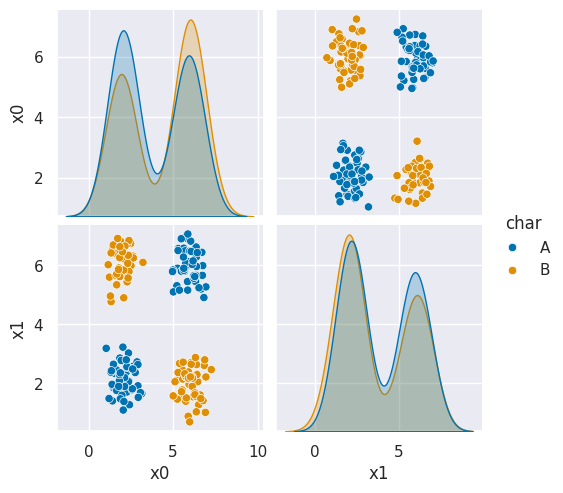
As we can see in this dataset, these classes are quite separated.
To do any ML we have to split the data into train and test sets. We will also set a random state.
random_state0 = 67
X_train, X_test, y_train, y_test = train_test_split(df6[['x0','x1']],df6['char'],
random_state =random_state0)We will next instantiate a GNB object:
gnb = GaussianNB()and fit and score:
gnb.fit(X_train, y_train)
gnb.score(X_test,y_test)0.56This is not a very good score, even though the data looked very separable.
To see why, we can look at what it learned.
We will again sample from the generative model
N = 100
gnb_df = pd.DataFrame(np.concatenate([np.random.multivariate_normal(th, sig*np.eye(2),N)
for th, sig in zip(gnb.theta_,gnb.var_)]),
columns = ['x0','x1'])
gnb_df['char'] = [ci for cl in [[c]*N for c in gnb.classes_] for ci in cl]
sns.pairplot(data =gnb_df, hue='char',hue_order=['A','B'])<seaborn.axisgrid.PairGrid at 0x7f16e613fb60>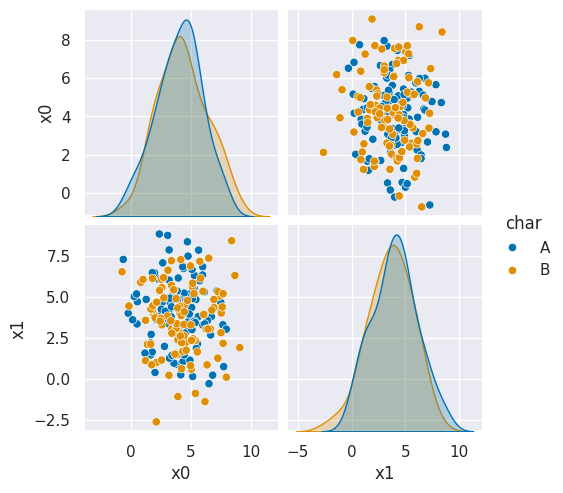
In this example, we can see it learned nearly the same mean and variance for both classes so it learned the classes as basically completely overlapping.
We can also inspect the means: array([[3.85630137, 3.92739726], [4.41298701, 3.64454545]]) and variances: array([[3.74042057, 3.83637816], [4.29385212, 4.24462999]]) directly and see they are not far apart.
Another way we can look at it is to view the predicted labels on the actual test data:
df6pred = X_test.copy()
df6pred['pred'] = gnb.predict(X_test)
sns.pairplot(df6pred,hue='pred',hue_order=['A','B'])<seaborn.axisgrid.PairGrid at 0x7f16e0e92c30>
Here we see it basically predicted one side as each class because
We can repeat this experiment with several different random states:
Notebook Cell
random_state_list = [4,5,3989,37,5893859]
gnb_corners_data = []
means = []
xylim = 0
for cur_rand_state in random_state_list:
cur_res = {'random_state':cur_rand_state}
X_train_r, X_test_r, y_train_r, y_test_r = train_test_split(df6[['x0','x1']],df6['char'],
random_state =cur_rand_state)
gnb.fit(X_train_r, y_train_r)
cur_res['score'] = float(np.round(gnb.score(X_test_r,y_test_r)*100,2))
df_sampled = pd.DataFrame(np.concatenate([np.random.multivariate_normal(th, sig*np.eye(2),N)
for th, sig in zip(gnb.theta_,gnb.var_)]),
columns = ['x0','x1'])
means.append(gnb.theta_)
df_sampled['char'] = [ci for cl in [[c]*N for c in gnb.classes_] for ci in cl]
df_sampled['type']= 'sampled'
df_train = X_train_r.copy()
df_train['char'] = y_train_r
df_train['type'] = 'train'
df_test = X_test_r.copy()
df_test['char'] = gnb.predict(X_test_r)
df_test['type'] = 'pred'
cur_res['df'] = pd.concat([df_sampled, df_train, df_test],axis=0)
xylim = max(xylim,cur_res['df'][['x0','x1']].max().max())
# cur_res['test_plot'] = sns.pairplot(cur_res['test'],hue='pred',hue_order=['A','B'])
gnb_corners_data.append(cur_res)
sns.set_theme(font_scale=2)
rand_scores = {'random_state':[],
'score':[]}
for res in gnb_corners_data:
rand_scores['score'].append(res['score'])
rand_scores['random_state'].append(res['random_state'])
score_df = pd.DataFrame(rand_scores)And we can look at the sampled data, training data, and predictions for each of these differen random seed values
With random state: 4, we got a score of 72.0 %
<seaborn.axisgrid.FacetGrid at 0x7f16e0e6c590>
With random state: 5, we got a score of 34.0 %
<seaborn.axisgrid.FacetGrid at 0x7f16e0b5c590>
With random state:3989, we got a score of 68.0 %
<seaborn.axisgrid.FacetGrid at 0x7f16e0753620>
With random state: 37, we got a score of 56.0 %
<seaborn.axisgrid.FacetGrid at 0x7f16e0639370>
With random state: 5893859, we got a score of 56.0 %
<seaborn.axisgrid.FacetGrid at 0x7f16e7d892b0>
Notice that over a bunch of random splits of the data we got a variety of different solutions, but all of them have a similarity tht the means and variances are not far apart, so GaussianNB always learns basically the same representation for both classes.
Then the predictions are not very good. At most ~75% correct.
Decision Trees¶
This data does not fit the assumptions of the Naive Bayes model, but a decision tree has different assumptions: It basically learns a flowchart for deciding what class the sample belongs to at test time . It can be more complex, but for the scikit learn one relies on splitting the data at a series of points along one feature at a time, sequentially.
It’s only assumption is that we can make cuts along one feature at a time.
It is a discriminative model, because it describes how to discriminate (in the sense of differentiate) between the classes. This is in contrast to the generative model that describes how the data is distributed.
That said, sklearn makes using new classifiers really easy once have learned one. All of the classifiers have the same API (same methods and attributes).
Let’s instantiate the object for a decision tree.
dt = tree.DecisionTreeClassifier()and fit
dt.fit(X_train,y_train)and score
dt.score(X_test,y_test)0.98much better than the first model, that used the same random seed (67) or any of the random trials with other random seeds.
The sklearn estimator objects (that corresond to different models) all have the same API, so the fit, predict, and score methods are the same as above. We will see this also in regression and clustering. What each method does in terms of the specific calculations will vary depending on the model, but they’re always there.
How do Decision trees make predictions¶
the tree module also allows you to plot the tree to examine it.
plt.figure(figsize=(15,20))
tree.plot_tree(dt, rounded =True, class_names = ['A','B'],
proportion=True, filled =True, impurity=False,fontsize=13);
To make a prediction, once we have the tree, the algorithm follows it like a flow chart.
So for example, for the first test sample
X_test.iloc[0:1]The tree first looks at feature x0 and compares to 5.88, since it is less than that it goes to the left node (labeled True). Next it compares feature x1 to 5.525, it’s also less than that so it goes left again, then x1 to 4.0, which is also true so we go left again and then predict class A.
We can check this result:
dt.predict(X_test.iloc[0:1])array(['A'], dtype=object)Pick a different test sample and manually trace it out. The confirm your answer by looking at the actual prediction.
Solution to Exercise 1
You can pick any value like:
my_sample_choice = 5
my_point = X_test.iloc[my_sample_choice:my_sample_choice+1]
my_pointand then go through the flow chart above (or your own)
dt.predict(my_point)array(['B'], dtype=object)as long as my_sample_choice< 50
On the iris dataset, the sklearn docs include a diagram showing the decision boundary You should be able to modify this for another classifier.
You can see an example of how it works in detailed code in the sklearn docs
Setting Classifier Parameters¶
The decision tree we had above has a lot more layers than we would expect. This is really simple data so we still got pretty good. However, the more complex the model, the more risk that it will learn something noisy about the training data that doesn’t hold up in the test set. This is called overfitting, we might also say that a classifier that is too complex does not generalize well.
Fortunately, we can control the parameters to make it find a simpler decision boundary.
max depth¶
One way we can do this is by setting the max_depth or the maximum number of height of the tree. The tree above has a depth of 7, but looking at the data we can see it seems like only 2 should be possible.
dt2 = tree.DecisionTreeClassifier(max_depth=2,)
dt2.fit(X_train,y_train)
dt2.score(X_test,y_test)0.76This does not do as well, we can check the training accuracy
dt2.score(X_train,y_train)0.78this is better, but not much. In general, when the test and train accuracies are close, that means a more complex model will not yet be overfitting.
We can cagain look at the tree
plt.figure(figsize=(15,20))
tree.plot_tree(dt2, rounded =True, class_names = ['A','B'],
proportion=True, filled =True, impurity=False,fontsize=13);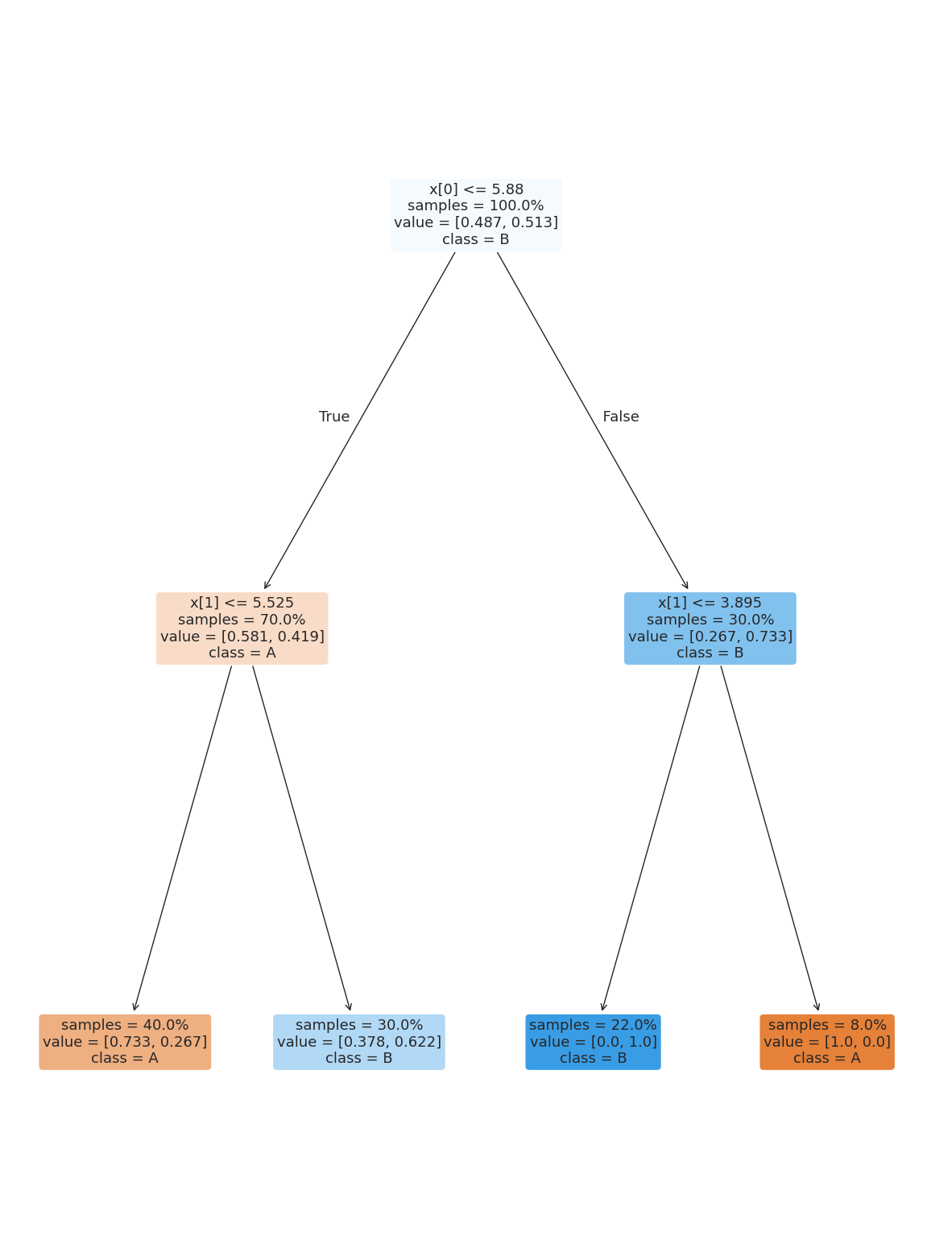
We can also try one more level
dt3 = tree.DecisionTreeClassifier(max_depth=3)
dt3.fit(X_train,y_train).score(X_test,y_test)0.94This does well!
Splitting rul¶
The splitting rule Or make it more random:
dt2 = tree.DecisionTreeClassifier(max_depth=2,splitter='random',
random_state=239)
dt2.fit(X_train,y_train).score(X_test,y_test)0.86this random seed happens to do better but others do not.
plt.figure(figsize=(15,20))
tree.plot_tree(dt2, rounded =True, class_names = ['A','B'],
proportion=True, filled =True, impurity=False,fontsize=13);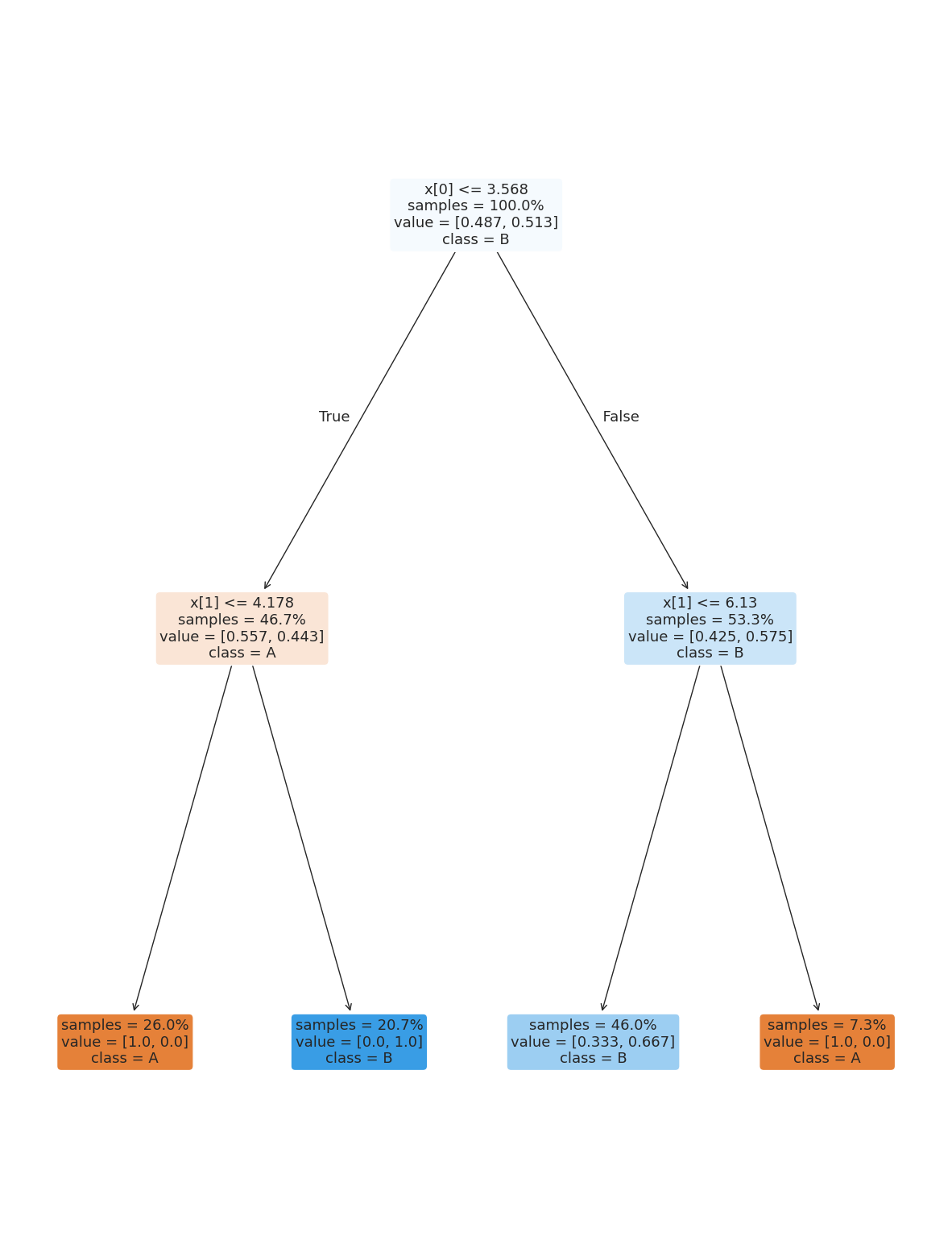
Minimum Split size¶
We can also set the minimum number of samples required to make a split. We can use an integer to set it in terms of number of samples or a float as a percentage.
This means that at any node with less that this percentage of the data must be a leaf node.
dt_large_split = tree.DecisionTreeClassifier(min_samples_split=.2)
dt_large_split.fit(X_train,y_train)
dt_large_split.score(X_test,y_test)0.98plt.figure(figsize=(15,20))
tree.plot_tree(dt_large_split, rounded =True, class_names = ['A','B'],
proportion=True, filled =True, impurity=False,fontsize=10);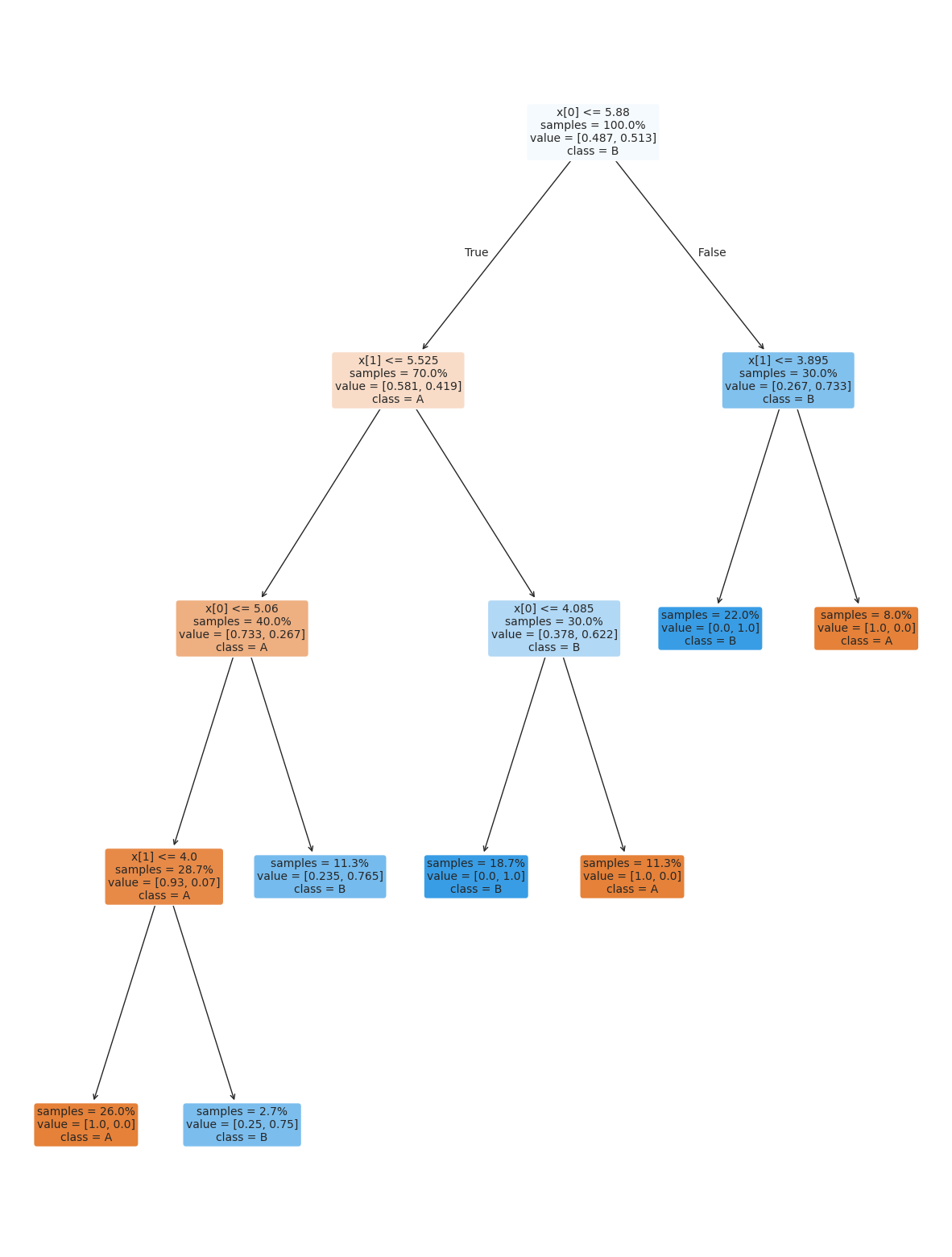
Minimum Leaf Samples¶
This is the number of samples that are required to make a leaf
dt_large_leaf = tree.DecisionTreeClassifier(min_samples_leaf=.2)
dt_large_leaf.fit(X_train,y_train)
dt_large_leaf.score(X_test,y_test)0.56plt.figure(figsize=(15,20))
tree.plot_tree(dt_large_leaf, rounded =True, class_names = ['A','B'],
proportion=True, filled =True, impurity=False,fontsize=10);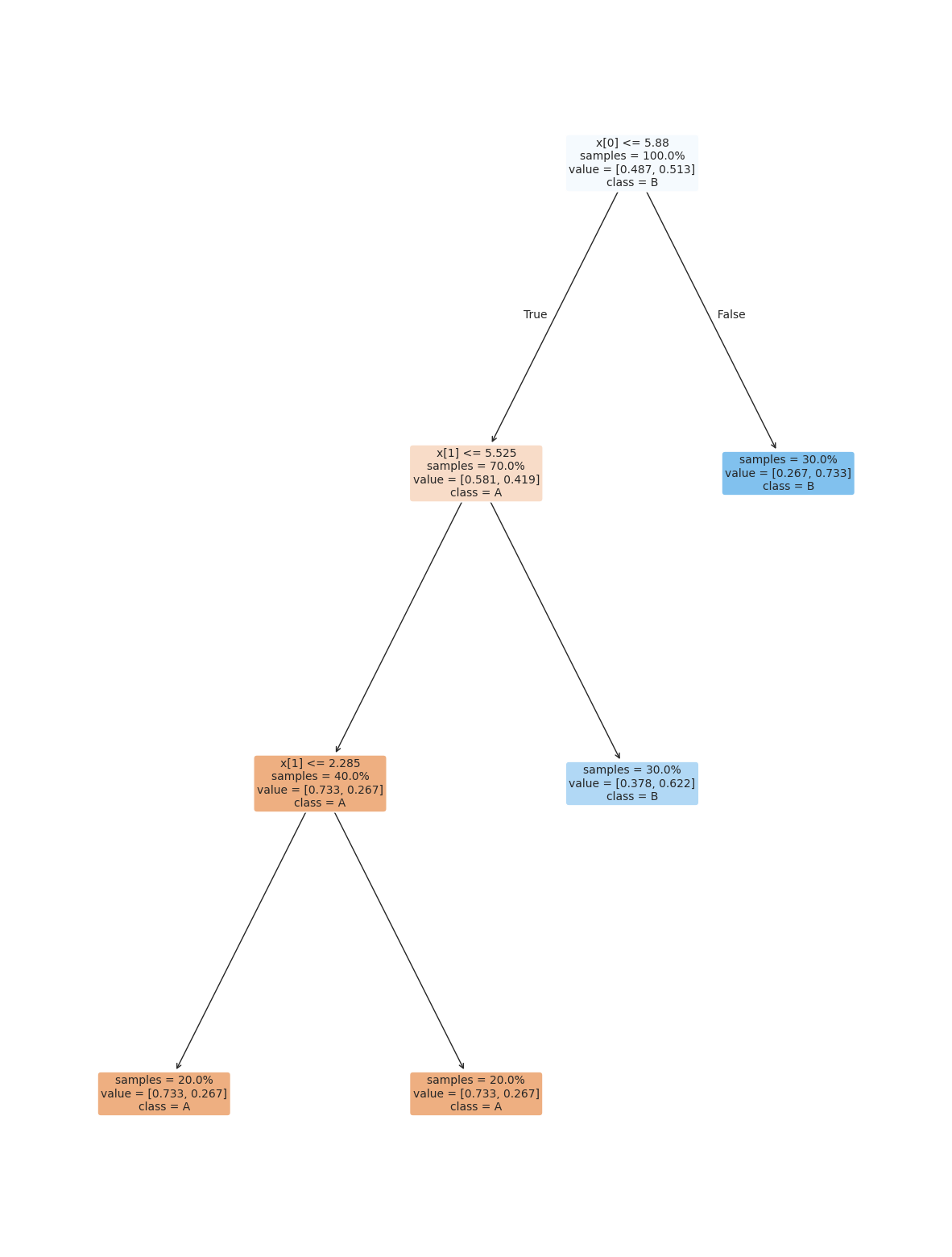
Multiple Parameters can be used together¶
dt_large_leaf2_d2 = tree.DecisionTreeClassifier(min_samples_split=.15,max_depth=2)
dt_large_leaf2_d2.fit(X_train,y_train)
dt_large_leaf2_d2.score(X_test,y_test)0.76plt.figure(figsize=(15,20))
tree.plot_tree(dt_large_leaf2_d2, rounded =True, class_names = ['A','B'],
proportion=True, filled =True, impurity=False,fontsize=10);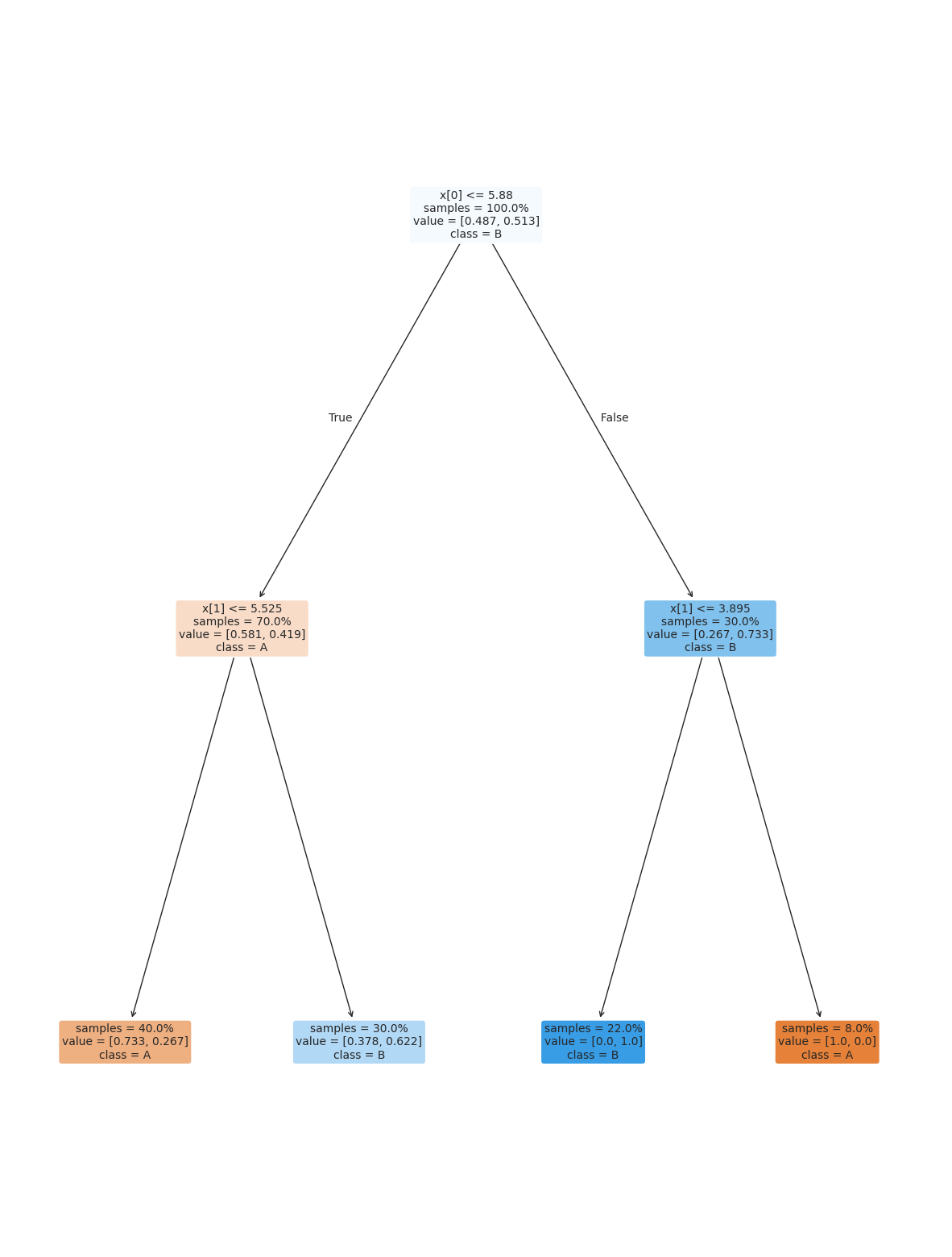
More Performance Metrics¶
Generate a classification_report for the dt_large_split model.
Hint
Try to remember (or hover to look) how we got the predictions on Tuesday, when we looked at the confusion matrix
Solution to Exercise 2
y_pred = dt_large_split.predict(X_test)
print(classification_report(y_test,y_pred,labels=['A','B'])) precision recall f1-score support
A 0.97 1.00 0.98 28
B 1.00 0.95 0.98 22
accuracy 0.98 50
macro avg 0.98 0.98 0.98 50
weighted avg 0.98 0.98 0.98 50
Interpret the classification report to say what kinds of mistakes were/were not made by this classifier.
Interpret the precision and the recall for each class.
Solution to Exercise 3
y_pred = dt_large_split.predict(X_test)
y_predA = y_pred =='A'
y_predB = y_pred =='B'
y_testA = y_test == 'A'
y_testB = y_test == 'B'
print(classification_report(y_test,y_pred,labels=['A','B']))
np.round(sum(y_pred[y_testA]==y_test[y_testA])/sum(y_testA),2) precision recall f1-score support
A 0.97 1.00 0.98 28
B 1.00 0.95 0.98 22
accuracy 0.98 50
macro avg 0.98 0.98 0.98 50
weighted avg 0.98 0.98 0.98 50
np.float64(1.0)The overall accuracy is 98%, it has a support of 50, because there are 50[1] total samples in the test set.
For class
Athe precision is 97%, which means that 0.97[1] of the samples where it predictedA. Specifically it was correct 28 times out of 29Apredictions.For class
Bthe precision is 100%, which means that np.float64(1.0)[1] of the samples where it predictedB. Specifically it was correct 21 times out of 21Apredictions.For class
Athe recall is 100%, which means that 1.0[1] of the samples where it predictedA. Specifically it was correct 28 times out of 28 trueAsamples.For class
Bthe recall is 95%, which means that 0.95[1] of the samples where it predictedA. Specifically it was correct 21 times out of 22 trueBsamples.
For more practice, you can also go back over the notes from the COMPAS audit and try the exercises on that page.
Questions¶
I added in some questions from previous semesters because few questions were asked.
Are there any good introductions to ScikitLearn that you are aware of?¶
Scikit Learn User Guide is the best one and they have a large example gallery.
Are there any popular machine learning models that use decision trees?¶
Yes, a lot of medical appilcations do, because since they are easy to understand, it is easier for healthcare providers to trust them.
Do predictive algorithms have pros and cons? Or is there a standard?¶
Each algorithm has different properties and strengths and weaknesses. Some are more popular than others, but they all do have weaknesses.
how often should we use confusion matrixes? Would it be better just to check the accuracy without one?¶
A confusion matrix gives more detail on the performance than accuracy alone. If the accuracy was like 99.99 maybe the confustion matrix is not informative, but otherwise, it is generally useful to understand what types of mistakes as context for how you might use/not use/ trust the model.
Due to the initial ‘shuffling’ of data: Is it possible to get a seed/shuffle of data split so that it that does much worse in a model?¶
Yes you can get a bad split, we will see next week a statistical technique that helps us improve this. However, the larger your dataset, the less likely this will happen, so we mostly now just get bigger and bigger datasets.
How does gnb = GaussianNB() work?¶
this line calls the GaussianNB class constructor method with all default paramters.
This means it creates and object of that type, we can see that like follows
gnb_ex = GaussianNB()
type(gnb_ex)sklearn.naive_bayes.GaussianNBCan you put into words, how the classification report with row A being real positive and B being negative and vise versa when looking at row B in the notes would be very muh appreicated¶
In the classification report, instead of treating one class as positive and one as negative overall, it treats each class as the positive class for one row. This is beacuse the report can be generated for more than two classes.
For example in the iris data:
print(classification_report(y_test,y_pred)) precision recall f1-score support
setosa 1.00 1.00 1.00 12
versicolor 0.87 0.93 0.90 14
virginica 0.91 0.83 0.87 12
accuracy 0.92 38
macro avg 0.93 0.92 0.92 38
weighted avg 0.92 0.92 0.92 38
There are 3 classes so we get a precision, recall and f1score for each of the three classes.
So the veriscolor row treats versicolor as the positive class and both the setosa and virginica as the negative class.
When do we use a decision tree?¶
A decision tree is a good model, when you want it to be interpretable, but do not need a generative model (we cannot generate sampels from a decision tree).
I have trouble interpreting the built-in feature of shift+tab. How can I gain a better understanding of what it means?¶
I am not 100% sure what this question is asking, if this answer doesn’t work, try asking again either with an issue on the repo or in office hours
The shift+tab feature shows the docstring from the function.
there is a pep[2] for docstrings
the pep8 guide might help
most scientific computing docstrings are numpydoc style (example spec)